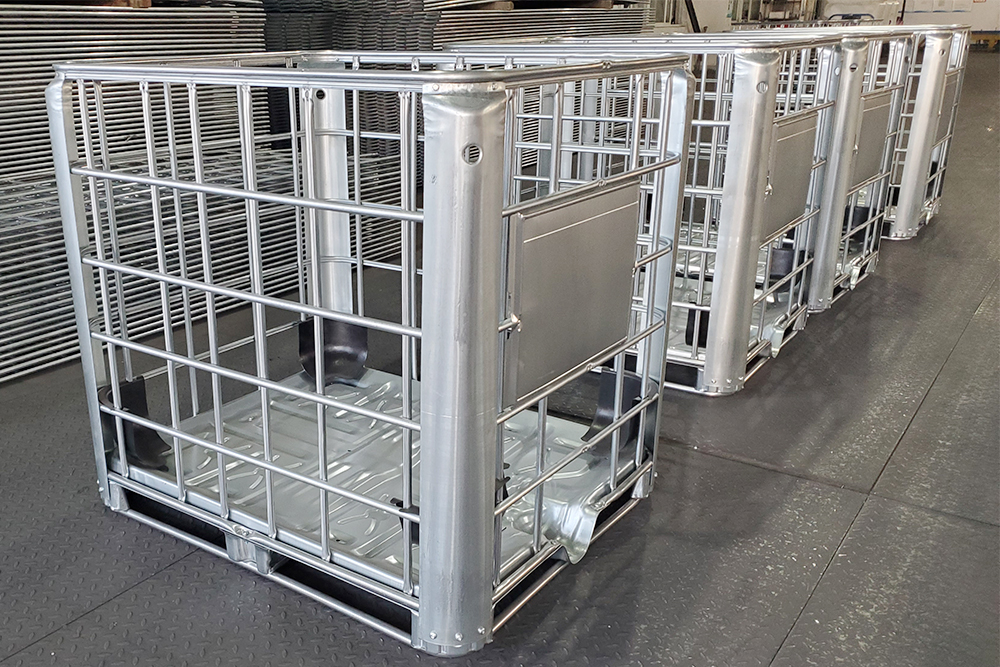
Do IBC Totes Need the Metal Cage?
Are metal cages necessary for IBC totes? This is a critical question for safety and engineering. The plastic tank can hold liquid on its own. However, the metal cage is key for safety, meeting regulations, and boosting efficiency. This article examines the role of metal cages in IBC systems. It covers their structural and safety importance, related regulations, and possible alternative designs.
The Critical Role of Metal Cages in IBC Tote Systems
Structural Integrity and Load Distribution
The metal cage is essential for IBC totes. It helps the flexible plastic container stay strong. This way, it can safely hold thousands of pounds of liquid. This setup stops warping and any risk of failure.
Key Load Specifications:
- A full 275-gallon tote weighs about 2,300 pounds
- A 330-gallon tote can exceed 2,750 pounds
- For HDPE totes: supports up to 1.8 times their weight
- For steel-framed cages: supports up to 2.5 times their weight
- On average, a new 275-gallon IBC tote costs from $200
- Pursuant to Repackify – Used 275-gallon IBC tote will cost you from $30
This capacity relies on its tubular steel design. Square tube designs, such as Greif’s, offer greater strength.
Protection Against Physical Damage
The metal cage around IBC totes is essential. It protects the plastic tank inside from damage while being moved or handled. This cage guards against impacts, punctures, and stress.
Critical Safety Statistics:
- 20% of IBC failures are due to forklift incidents
- Most IBC incidents are caused by mishandling
- The cage blocks sharp objects and equipment
Therefore, the cage’s protective function is key for safe operations.
Operational Efficiency and Handling Capabilities
IBC tote metal cages are key for easy handling in logistics and industry. The cage fits a standard pallet base (48″L x 40″W). It has four-way forklift access, so it works well in global logistics.
Operational Benefits:
- The solid frame allows for stacking to save space
- You can typically stack two high, or more depending on the load
- Standard 45″L x 45″W dimensions and the square shape further optimize space utilization
Construction Materials and Design Specifications
Metal Cage Materials and Manufacturing
IBC tote cages are made in various styles for different uses and quality levels.
Material Options:
- Standard steel cages: Strong, but tend to rust
- Galvanized steel cages: Resist corrosion well, protected by zinc layer
- Stainless steel cages: Protected by chromium oxide layer, long-lasting
Typically featuring welded tubular construction, some advanced designs utilize stronger square tubes. All cages need to follow specific engineering standards. This helps them fit the plastic tank and stay strong under various loads.
Plastic Tank Construction and Integration
Caged IBC totes have a flexible, blow-molded HDPE inner tank. They also feature a sturdy metal cage. This design offers both strength and lightweight benefits. Smart design spreads the load evenly, keeping the tank safe in the cage. This system sits on a pallet base. It makes the plastic tank and metal cage work together as one unit.
Safety Considerations and Regulatory Requirements
Pressure Limitations and Structural Integrity
IBC totes with metal cages are designed for atmospheric pressure only. They cannot be used for pressurization. The metal cage is key for support. It stops the plastic tank from bending during regular use.
Testing Standards:
- Production tests take place at 10 PSI
- Leakproofness tests are at 3 PSI
- Poly-caged IBC totes can burst at just 5 PSI, highlighting the metal cage’s importance for safe use
These tests check if the container is intact, not how much pressure it can safely handle.
Regulatory Compliance and Standards
IBC totes for hazardous materials need a metal cage. This is to follow safety rules from PHMSA and the EPA. These guidelines are in UN/DOT standards and 49 CFR.
Required Inspections:
- Internal pressure tests every 30 months
- Visual inspection every 30 months
- Internal checks every five years
These steps help certify it for transporting hazardous materials.
Fire Safety and Emergency Response
The metal cage on IBC totes is vital for fire safety. Composite IBCs pose fire risks because the plastic can melt and fuel flames. While the cage offers some shielding, it won’t prevent failure in extreme fires.
Fire Safety Requirements:
- NFPA 30 says that nonmetallic IBCs in protected buildings must be listed and labeled
- Currently, only the SCHÜTZ Ecobulk SX-D has UL listing
- The metal cage design is key for fire safety and emergency responses
Alternative Designs and Cageless IBC Solutions
Emergence of Cageless IBC Technologies
Cageless IBC totes have advantages for some uses. They are made from strong, thick polyethylene, which means no metal cage is needed.
Performance Comparison:
- Cageless designs last over 40 trips
- Traditional caged IBCs only last 5 to 10 trips
- The CageBuster IBC has walls three times thicker than regular caged bottles
This makes it much tougher against corrosion, impact, and chemical damage. This cageless design makes cleaning and maintenance easier. It has curved side walls, a sloped drain trough, and a stacking lug system that works with caged IBCs.
Comparative Analysis of Caged vs. Cageless Designs
Cost Analysis:
- Caged IBCs: Cheaper to buy but require more upkeep
- Cageless IBCs: Pricier at the start, but last longer and need less care
So, they end up being cheaper over time. Cageless options are more eco-friendly. They last longer and can be recycled easily. This means less waste in landfills compared to caged systems, which often use mixed materials that are tough to recycle.
Application-Specific Design Selection
Cageless IBC designs provide more strength and sustainability. This is important for industries that focus on safety and maintenance, such as the chemical sector.
Advantages:
- Their smooth interiors and sloped drains reduce residue
- Great for hazardous materials
- Meet strict standards for food-grade and pharmaceutical use
- Eliminate rust and corrosion risks that come with metal cages
Maintenance, Durability, and Lifespan Considerations
Metal Cage Deterioration and Maintenance Requirements
The metal cage of IBC totes needs regular care. This upkeep keeps them safe and helps meet regulations. Even top-quality galvanized and stainless steel cages can rust. This is especially true in tough conditions or places with a lot of rain. Standard steel cages can rust easily when they contact moisture and oxygen. This means they need regular checks and upkeep to stay in good shape.
Maintenance Best Practices:
- Look for rust regularly
- Apply coatings that resist weather
- Store them properly to cut down on moisture
- Keep the cage structure safe from damage
Scratches and dents can reveal bare metal. This can cause rust to form. Managing humidity and temperature can greatly increase how long cages last. This also helps keep them in good shape.
Structural Integrity and Failure Modes
IBC totes with metal cages have several ways they can fail. Issues can come from the plastic tank or the metal frame. This leads to multiple possible failure points. Industry analysis found 22 specific IBC failure and error mechanisms. Mechanical failures make up a large part of these incidents.
Common Failure Modes:
- Damage to the pallet base
- Leaks in the outlet valve
- Structural failures in the cage from impact or corrosion
A strong metal cage is key for IBC tote strength. This is important when stacking them under heavy loads. Temperature and the environment play a big role in how well the plastic tank and metal cage work. Finite element analysis shows that standard designs can experience high stress and deformation. This points to the need for solid cage designs and regular upkeep.
Ultraviolet Degradation and Environmental Factors
When IBC tote plastic is exposed to environmental factors like UV rays for too long, it breaks down. This results in brittleness, cracks, and ultimately failure. The metal cage plays a key role. It protects the plastic tank from UV damage and adds stability. Failure of UV-damaged composite containers left outside increases fire risk to nearby buildings.
Industry Applications and Specialized Use Cases
Chemical and Hazardous Material Handling
IBC totes in the chemical industry store hazardous materials. They rely on a metal cage to follow strict DOT transport rules. The cage provides crucial impact protection, chemical resistance, and structural integrity during transportation.
Safety Features:
- Specific cage features like fusible vents and secondary closures enhance safety
- The cage makes it easier to label and placard items
- Important for meeting regulations and responding to emergencies
Food and Beverage Industry Requirements
IBC tote design in the food and beverage industry needs to meet high hygiene standards. It must also be durable for safe transport. The metal cage is key for easy cleaning and sanitization. It also protects the inner plastic tank from contamination.
Food-Grade Requirements:
- Special materials for the tank and cage
- Ensures safety and meets regulations
- The cage design needs to allow for total drainage and easy cleaning
- Must support the plastic tank during heavy cleaning in food processing areas
- Standard cage dimensions ensure compatibility with existing equipment
Agricultural and Industrial Applications
IBC totes are key in farming. They store and transport fertilizers, pesticides, and chemicals. Their metal cage is strong for fieldwork. It protects the inner tank from stress caused by equipment. It’s also built to resist farm equipment and environmental factors.
Industrial Benefits:
- In fields such as water storage, construction, and chemical processing, the cage gives a reliable base
- It handles various materials and works well with industrial equipment
- The standardized cage design allows IBC totes to fit in many industrial setups
- It works for any specific application
Economic and Environmental Considerations
Cost-Benefit Analysis of Cage Systems
Caged IBC totes have lower initial costs, appealing for budget-conscious or short-term use. A full cost analysis, accounting for maintenance and replacement, may support other designs for long-term use.
Economic Advantages:
- The metal cage is stackable, easy to handle, and works well with logistics
- This saves on transportation and handling costs
- It helps warehouses work better and makes the supply chain more flexible
- This standardization simplifies logistics planning and lowers overall supply chain expenses
Environmental Impact and Sustainability
Metal cages on IBC totes harm the environment. They use a lot of materials and energy to make. Also, their mixed metal and plastic parts create problems when it comes to disposal and recycling. Still, they do offer operational benefits.
Sustainability Considerations:
- Cageless IBC designs make sustainability easier
- They are easier to recycle, use less material, and last longer than metal cages
- The transition to these designs requires careful consideration of both benefits and safety
Popular Categories





